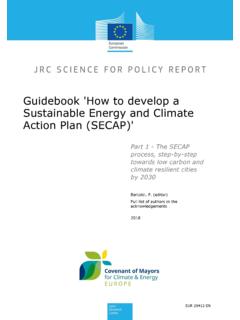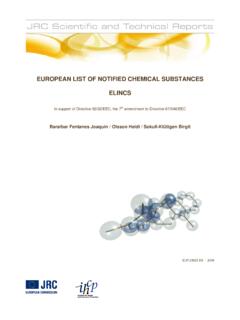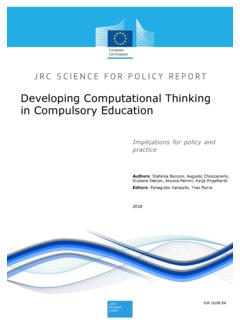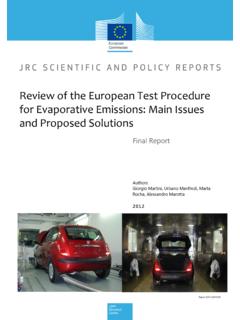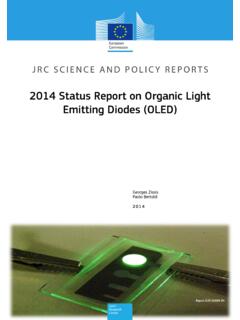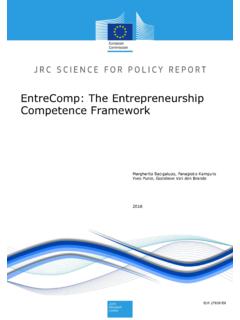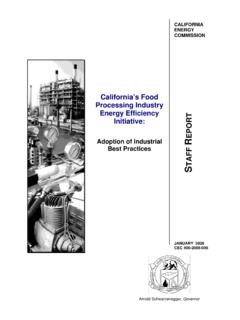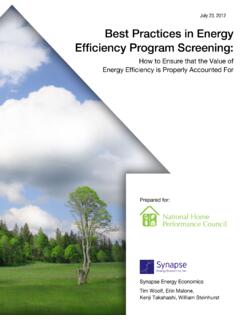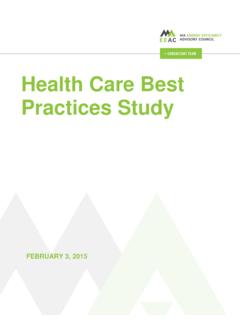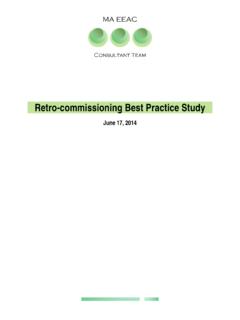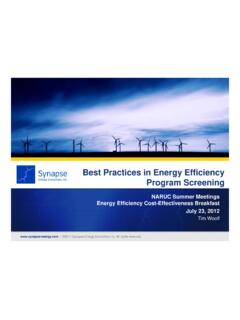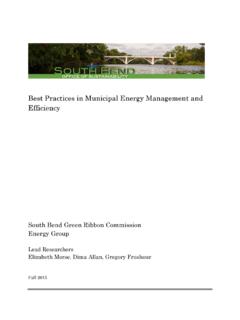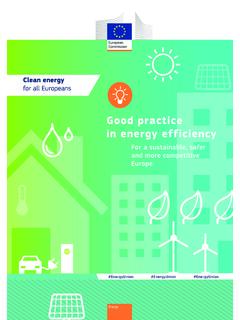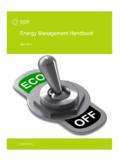Transcription of 2018 Best Practice Guidelines for the EU Code of …
1 2018 best Practice Guidelines for the EU Code of Conduct on data Centre energy efficiency Version Mark Acton Paolo Bertoldi John Booth Liam Newcombe Andre Rouyer Robert Tozer 2018 . EUR 29103 EN. This publication is a Technical report by the Joint Research Centre (JRC), the European Commission's science and knowledge service. It aims to provide evidence-based scientific support to the European policymaking process. The scientific output expressed does not imply a policy position of the European Commission. Neither the European Commission nor any person acting on behalf of the Commission is responsible for the use that might be made of this publication. Contact information Name: Paolo Bertoldi Address: Joint Research Centre, Via Enrico Fermi 2749, TP 450, 21027 Ispra (VA), Italy Email: Tel.: +39 0332 78 9299. JRC Science Hub JRC110666. EUR 29103 EN. PDF ISBN 978-92-79-79371-4 ISSN 1831-9424 Luxembourg: Publications Office of the European Union, 2018 . European Union, 2018 .
2 Reuse is authorised provided the source is acknowledged. The reuse policy of European Commission documents is regulated by Decision 2011/833/EU (OJ L 330, , p. 39). For any use or reproduction of photos or other material that is not under the EU copyright, permission must be sought directly from the copyright holders. How to cite this report: Acton, M., Bertoldi, P., Booth, J., Newcombe, L., Rouyer, A. and Tozer, R., 2018 best Practice Guidelines for the EU Code of Conduct on data Centre energy efficiency , EUR 29103 EN, Publications Office of the European Union, Luxembourg, 2018 , ISBN 978-92-79-79371-4, , JRC110666. All images European Union 2018 . Contents Abstract .. 1. 1 Document Information .. 2. Version History .. 2. Release History .. 2. Authors .. 2. 2 Introduction .. 3. Role of best practices .. 3. Expected Minimum practices .. 3. Application and Assessment .. 4. Value of practices .. 4. Applicability of Expected practices .. 4. Type of Participant.
3 5. Participants who do not control the entire data centre .. 5. Guidance to operators with partial control of the data centre .. 5. Areas of Responsibility .. 6. Implement or Endorse .. 7. 3 data Centre Utilisation, Management and Planning .. 8. Involvement of Organisational Groups .. 8. General Policies .. 9. Resilience Level and Provisioning .. 12. 4 IT Equipment and Services .. 13. Selection and Deployment of New IT Equipment .. 13. Deployment of New IT Services .. 19. Management of Existing IT Equipment and Services .. 20. data Management .. 21. 5 23. Air Flow Management and Design .. 23. Cooling Management .. 27. Temperature and Humidity Settings .. 28. Cooling Plant .. 30. Free Cooling / Economised 30. High efficiency Cooling Plant .. 33. Computer Room Air Conditioners / Air Handlers .. 35. Reuse of data Centre Waste Heat .. 37. 6 data Centre Power Equipment .. 38. Selection and Deployment of New Power Equipment .. 38. i Management of Existing Power Equipment.
4 39. 7 Other data Centre Equipment .. 40. General practices .. 40. 8 data Centre Building .. 41. Building Physical Layout .. 41. Building Geographic Location .. 42. Water sources .. 42. 9 Monitoring .. 43. energy Use and Environmental Measurement .. 43. energy Use and Environmental Collection and Logging .. 44. energy Use and Environmental Reporting .. 45. IT Reporting .. 46. 10 practices to become minimum expected .. 47. 11 Items under Consideration .. 48. ii EU Code of Conduct on data Centre energy efficiency - Version Abstract The Information and Communication Technology (ICT) sector including data centres generates up to 2% of the global CO2 emissions and data centres are estimated to have the fastest growing carbon footprint from across the whole ICT sector, mainly due to new business such as the cloud computing and the rapid growth of the use of Internet services. The European Code of Conduct for data Centre energy efficiency programme is a voluntary initiative created in 2008 in response to the increasing energy consumption in data centres and the need to reduce the related environmental, economic and energy supply security impacts.
5 Companies participating on the Code of Conduct have to adopt best practices for energy management in data centres. The present report supplement to the Code of Conduct and present the updated (year 2018 ) version of the best practices . This report is provided as an education and reference document as part of the Code of Conduct to assist data centre operators in identifying and implementing measures to improve the energy efficiency of their data centres. A broad group of expert reviewers from operators, vendors, consultants, academics, professional and national bodies have contributed to and reviewed the best practices . This report provides a full list of the identified and recognised data centre energy efficiency best practices within the Code of Conduct. Customers or suppliers of IT services may also find it useful to request or provide a list of Code of Conduct practices implemented in a data centre to assist in procurement of services that meet their environmental or sustainability standards.
6 1. EU Code of Conduct on data Centre energy efficiency - Version 1 Document Information Version History Version Description Version Updates Date Comments from 2017 best practices 2018 Initial Draft 14 Nov 2017. stakeholders meeting incorporated 2018 Review Draft Comments from initial draft incorporated 21 Nov 2017. 2018 Final Release Version 01 Dec 2018 . Release History Version Description Authoriser Date 2018 Release Mark Acton 01 Jan 2018 . 2017 Release Mark Acton 01 Jan 2017. 2016 Release Mark Acton 06 Jan 2016. 2015 Release Fix Mark Acton 02 Jan 2015. 2015 Release Mark Acton 10 Dec 2014. 2014 Release Fix Mark Acton 23 Feb 2014. 2014 Release Mark Acton 17 Feb 2014. 2013 Release Mark Acton 30 May 2013. 2012 Release Liam Newcombe 15 Dec 2011. 2011 Release Fix Liam Newcombe 01 Mar 2011. 2011 Release Liam Newcombe 28 Feb 2011. 2010 Release Liam Newcombe 19 Nov 2009. First Release Liam Newcombe 23 Oct 2008. Authors The following people are the current editorial team associated with this document Author Organisation Mark Acton CBRE data Centre Solutions Paolo Bertoldi EC Joint Research Centre (JRC).
7 John Booth Carbon3 IT. Liam Newcombe BCS data Centre Specialist Group Andre Rouyer The Green Grid Robert Tozer Operational Intelligence 2. EU Code of Conduct on data Centre energy efficiency - Version 2 Introduction This document is a companion to the EU Code of Conduct on data Centre energy efficiency and provides the full list of identified best practices for data centre operators as referenced in the Code of Conduct Participant and Endorser Guidelines documents. Role of best practices This best Practice supplement to the Code of Conduct is provided as an education and reference document as part of the Code of Conduct to assist data centre operators in identifying and implementing measures to improve the energy efficiency of their data centres. A broad group of expert reviewers from operators, vendors, consultants, academics, professional and national bodies have contributed to and reviewed the best practices . This best Practice supplement is a full list of the identified and recognised data centre energy efficiency best practices within the Code of Conduct.
8 The best Practice list provides a common terminology and frame of reference for describing an energy efficiency Practice , to assist Participants and Endorsers in avoiding doubt or confusion over terminology. Customers or suppliers of IT services may also find it useful to request or provide a list of Code of Conduct practices implemented in a data centre to assist in procurement of services that meet their environmental or sustainability standards. Expected Minimum practices To help ensure that Participants to the Code of Conduct are recognised as having committed to a useful and substantial level of energy saving effort, a subset of the best practices are identified in this document as being the expected minimum level of energy saving activity for Participant status. The less disruptive or intrusive of the practices are identified as being applied to the existing data centre and IT equipment, retrospectively where necessary. It is accepted that a number of the practices identified as expected are inappropriate or present an unnecessary burden when applied to an existing running data centre.
9 These practices are identified as being expected either, when new IT equipment or software is sourced and deployed, or during a retrofit of the facility. These practices provide substantial benefits and are intended to achieve efficiency improvements through the natural churn of equipment and facilities. All expected practices should be applied to any data centre constructed from 2011. onwards, specifically all practices marked as Entire data centre , New software , New IT. equipment and New build or retrofit which are within the applicants control. practices are marked in the expected column as;. Category Description Expected to be applied to all existing IT, Mechanical and Electrical Entire data Centre equipment within the data centre New Software Expected during any new software install or upgrade New IT Equipment Expected for new or replacement IT equipment Expected for any data centre built or undergoing a significant refit New build or retrofit of the M&E equipment from 2011 onwards practices without a background colour are optional for Optional practices Participants Note that existing IT equipment moved from another data centre is not expected to comply with the New IT Equipment or New Software practices .
10 New or replacement IT equipment excludes the direct replacement of failed hardware with like for like as part of normal 3. EU Code of Conduct on data Centre energy efficiency - Version operations. New software install or upgrade refers to major upgrades of software and not the application of service packs and patches in normal management and use. Retrofit is intended to describe major disruptive works in the data centre which present the opportunity at little incremental cost to implement these additional practices . Examples of retrofit would be (a) when the power to the data floor is shut off and the IT equipment and cabinets removed it is expected that Practice Contained hot or cold aisle would be implemented (b) if the CRAC / CRAH units are being upgraded or replaced it is expected that Practice Variable speed fans would be implemented as part of this change. Application and Assessment The best practices form part of the application and assessment for Participant status.
